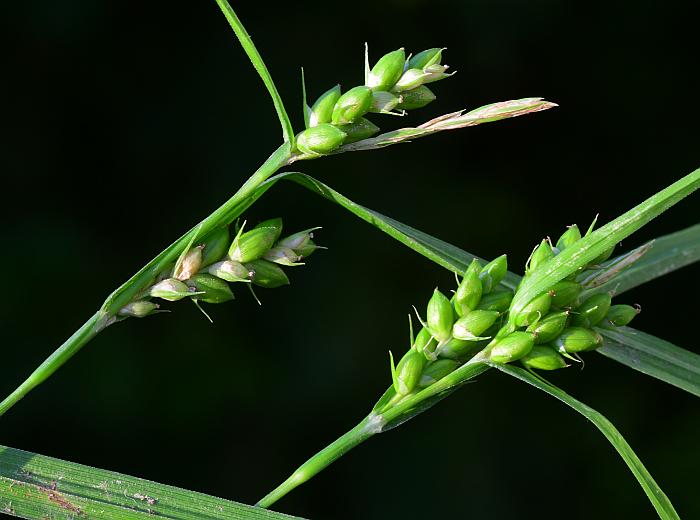Carex grisea Wahlenb.
Inflated Narrow-Leaf Sedge

Native
CC = 4
CW = 0
MOC = 96
© SRTurner
Carex grisea Wahlenb.Inflated Narrow-Leaf Sedge | |
 |
Native CC = 4 CW = 0 MOC = 96 |
© SRTurner |
|
Family - Cyperaceae Habit - Monoecious sedge, with rhizomes very short or lacking, forming clumps. Stems - Flowering stems 15-80 cm long, erect to spreading, brown or sometimes dark reddish purple at the base. Leafy vegetative stems usually present.
Leaves - Leaf blades 1-50 cm long, 3-9 mm wide, flat. Leaf sheaths glabrous, the tip truncate or shallowly concave, the lowermost, nearly bladeless sheaths brown or sometimes dark reddish purple.
Inflorescences - Spikes 3-6 per stem, the bracts of the uppermost pistillate spikes longer than the inflorescence. Staminate spike 7-35 mm long, sessile or short-stalked, the stalk smooth. Staminate scales 3-5 mm long, narrowly oblong to narrowly ovate, white to light brown with green midrib, occasionally with sparse, red spots. Pistillate spikes 5-30 mm long, 4.5-9.0 mm wide, the uppermost sessile or short-stalked, the lowermost short-to long-stalked, the stalks smooth, ascending, with 3-27 strongly overlapping perigynia, these several-ranked, in a spiral pattern around the axis. Pistillate scales 2.0-5.5 mm long, the lowermost ones with the bodies as long as or longer than the associated perigynia, ovate to broadly ovate, the tip pointed and with a short to long, rough-margined awn, white with green midrib, sometimes with reddish purple spots or streaks.
Perigynia - Perigynia 3.9-4.5 mm long, 1.8-2.3 mm wide, ascending, elliptic to obovate in outline, the tip pointed, without a beak, tapered to a broad, more or less rounded base, circular in cross-section or nearly so.
Fruits - Fruits 3.0-3.7 mm long, the main body (excluding beak and stalklike base) 2.2-3.0 mm long, the beak 0.3-0.6 mm long, straight. Flowering - April - July. Habitat - Mesic upland forests, often on rich slopes of ravines or along bases of bluffs, bottomland forests, streambanks, upland prairies, fens, old fields, roadsides. Origin - Native to the U.S. Lookalikes - Numerous other species of Carex, particularly those within the Amphibola complex. Other info. - This is a common sedge of mesic and bottomland forests. It is probably found in every county of Missouri, and also occurs throughout the upper Midwest and into New England and Canada. Many sedges can be difficult to distingish. This species has a separate terminal staminate spike, glabrous stems and leaves, and perigynia which are elliptic, nearly round in cross section, and with numerous visible nerves on the surface. The pistillate scales are usually long tapered or awned, and have somewhat membranous lateral margins. Photographs taken at Weldon Spring Conservation Area, St. Charles County, MO, 6-2-2020, and at Shaw Nature Reserve, Franklin County, MO, 5-7-2021 (SRTurner). |